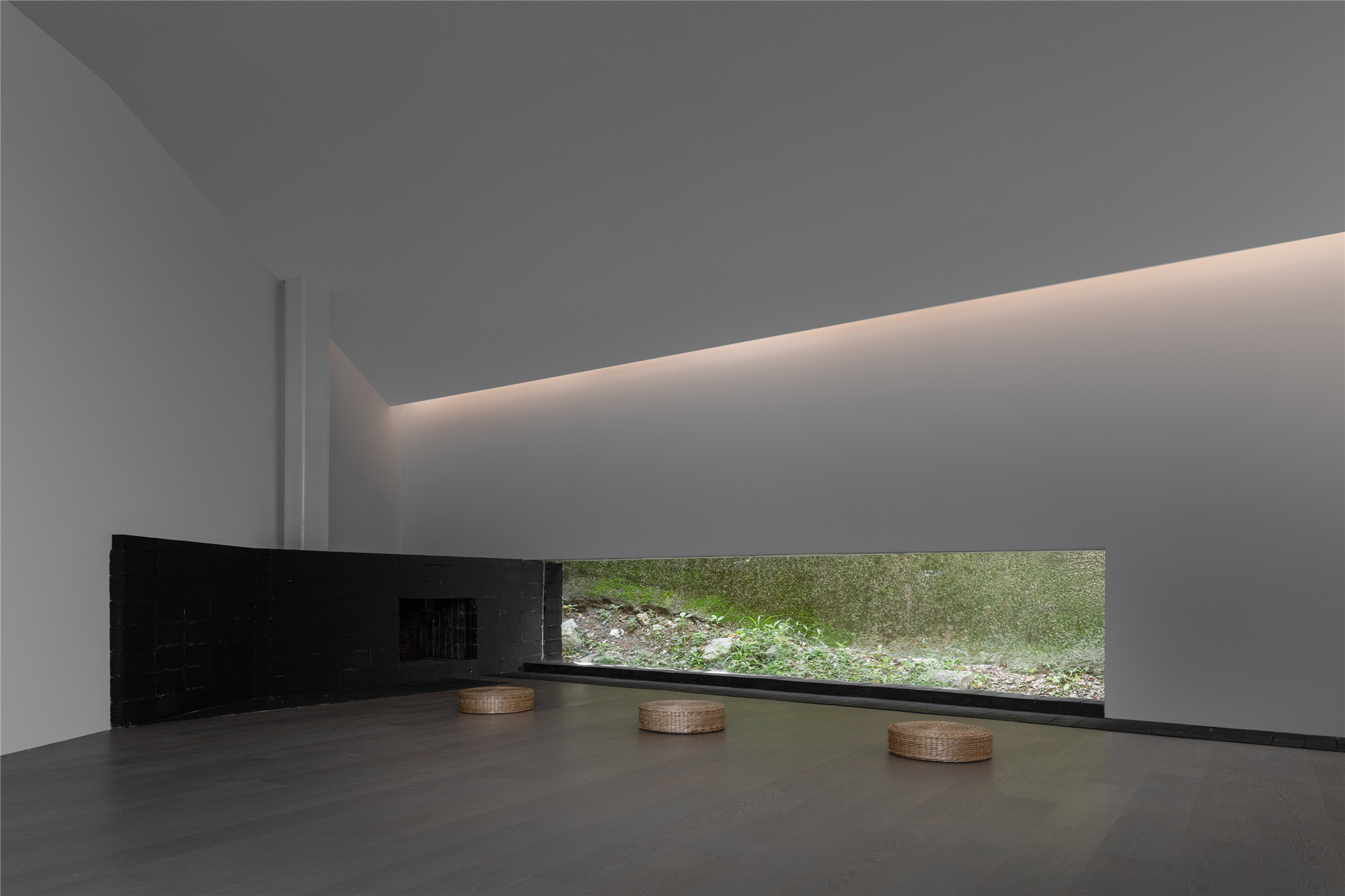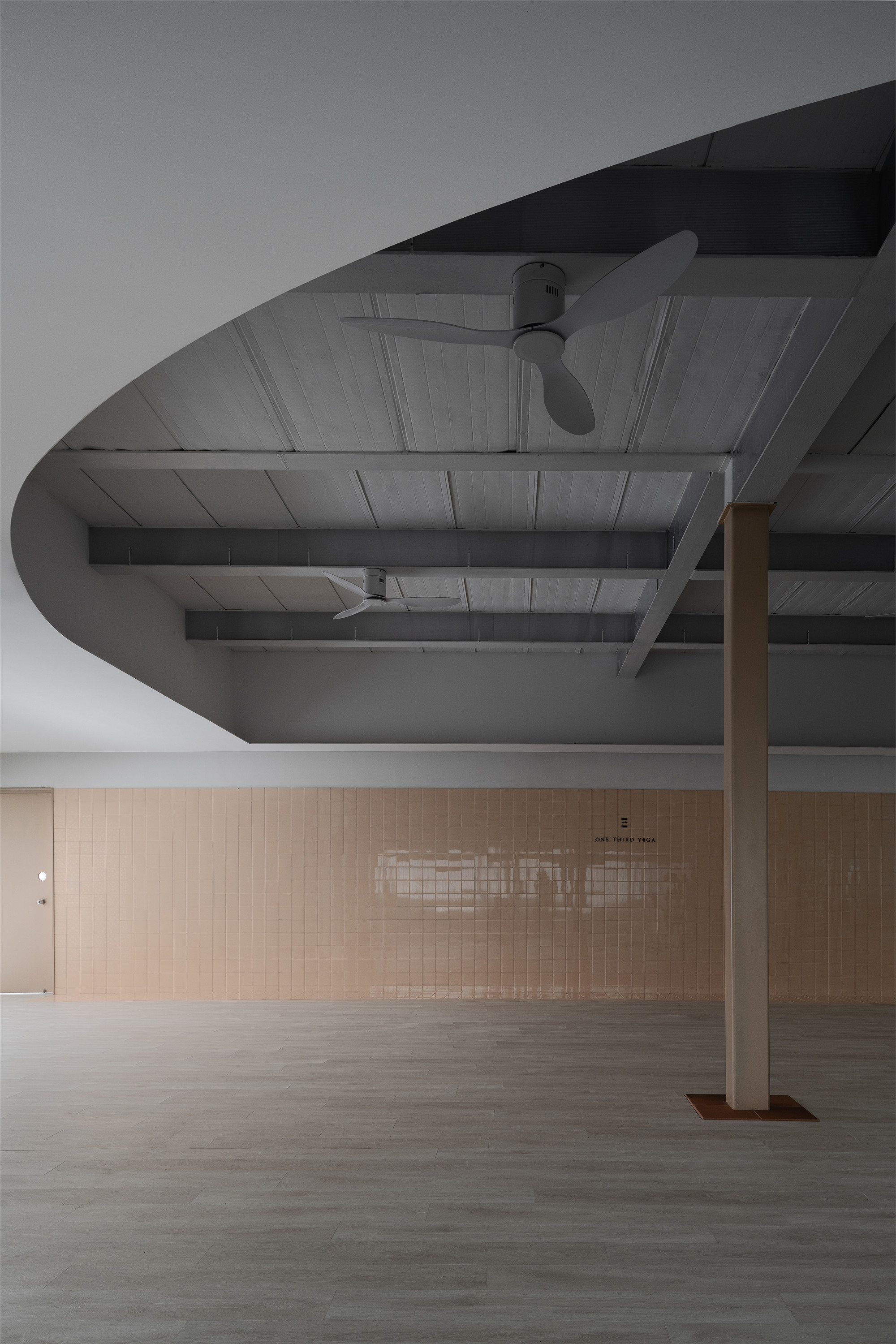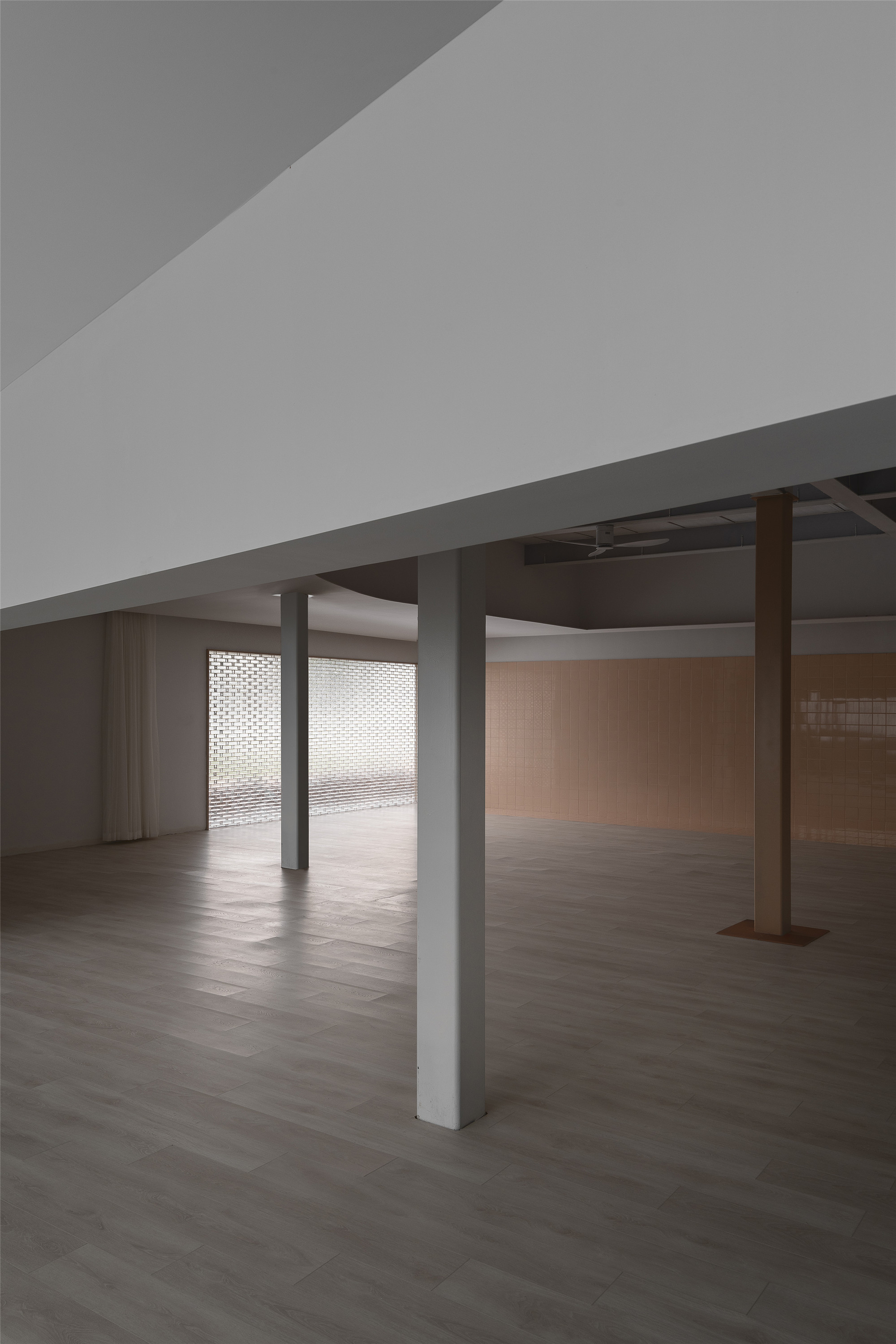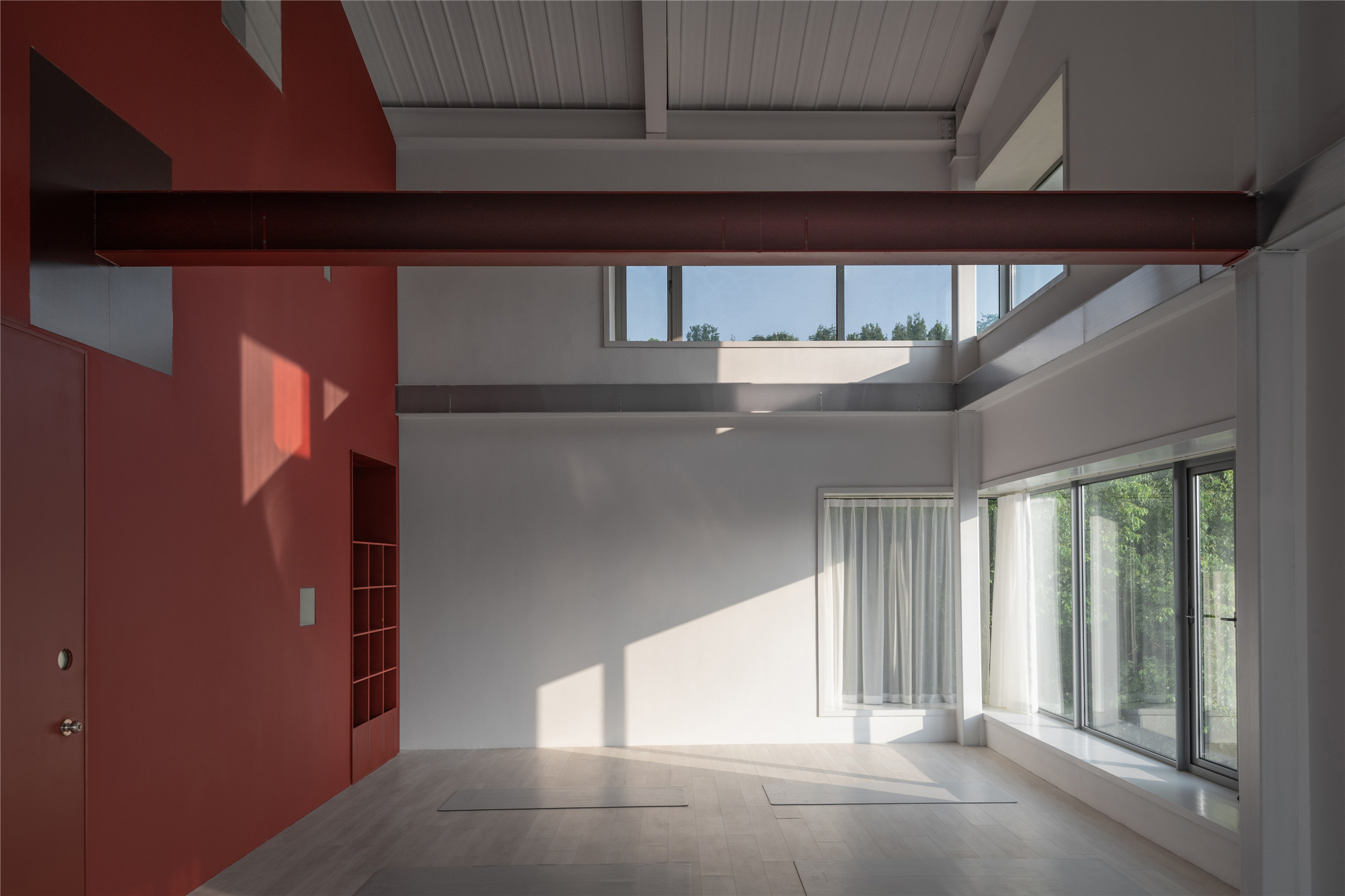
设计单位 边界空间设计
项目地点 浙江杭州
建成时间 2021年
建筑面积 750平方米
撰文 黄三秀
缘起
我们生活在城市中,城市盛放着我们的身体,我们的身体盛放着我们“自己”。每个人的“自己”,是一座孤岛,也是一座花园,我们终其一生,都在寻找、认识这个自我。通过经历、学习、伤痛、磨练、幸福感受自己,感受自己与外界的链接。这个链接过程,正是我们对瑜伽的理解。
We live in cities, where our bodies are contained, and in our bodies, “ourselves” are contained. The self of every person is an island, and also a garden. Throughout our lives, we’ve been looking for and learning about ourselves. Through experience, study, pain, tempering and happiness, we feel ourselves and our connection with the outer world. The connection process is our understanding of yoga.
接到项目委托,就是我们这次瑜伽习练的开始……
Receiving the project commission of ONE THIRD YOGA is also the start of this yoga practice…


开篇
建筑回应气候、场地、人文、功能和人等等因素,那室内应该回应什么?是否应该是在建筑需要关照的所有基础条件上再加上建筑?
Buildings echo with climate, site, culture, function and people, so what should interior echo with? Should it be adding buildings onto all the basic conditions to be concerned by buildings?
建筑条件是室内关于场地信息的最重要载体,这些都将是我们营建整理空间的原始依据。是“因借体宜”中可借用的对象,也是“随形顺势”中那重要的“势”与“形”。
Construction conditions are the most important carrier of site information for interior design, and all of them will be original bases for creating and organizing the space. They are borrowable objects in “interdependence, borrowing, appropriateness, suitability”, and the important “local conditions” when “adjusting to local conditions”.


随形与借势
项目在中国美院附近的艺术园区,地势最高的一个山坡台地上,背靠巨大的山墙,俯瞰园区的白色建筑群。院子的入口在一个U形坡道的尽头,院门躲在墙后,上几部台阶一个回转后,就能见到白色的三层建筑和一方建筑围抱的绿茵地。
Located in the art park near China Academy of Art, the project is on the highest hillside terrace and against the giant gable, overlooking the white building complex in the park. The entrance to the yard is at the end of a U-shape slope, hiding behind the wall. Go up a few steps and turn around, you can see a lawn surrounded by white three-floor buildings and a square building.

进入院子,石板和混凝土结合的路径导引我们直向建筑的入口。入口左侧的阳光亭和右侧的边廊都是加建所得,在尽量保持与原建筑关系统一的同时,来获取内部功能上的完整与丰富。也正是因为功能需求的变化,促使我们必须对空间重新梳理,这也连动了后续的对原建筑局部的加建和“篡改”。
Entering into the yard, a path of slabs and concrete lead us right to the entrance to the building. The sunlight pavilion on the left and the side porch on the right of the entrance are additions afterwards, to complete and enrich internal functions while trying to maintain unity with original buildings. Change of demands for functions drives us to re-organize the space, and lead to following additions and “alteration” to part of the original building.

首层的大厅是一层多功能空间和通往二三层的交通节点,兼顾接待功能。接待台叠放在延伸的楼梯踏步上,在两个不通顶的被体块化的功能空间(综合教室入口区与保洁间)的围合下,显得独立、安适。也正是因几个不通顶的空间体块,让连续的顶部模糊相互的空间边界,形成连续的整体空间感受。
The lobby on the first floor is the traffic node for multiple functional spaces on this floor and pathways to second and third floors, and it also includes reception. The reception desk is stacked on extending steps, and appear to be independent and comfortable surrounded by two modularized spaces (entrance area to the integrated classroom and the cleaner’s room) that don’t go to the ceiling. These space modules also enable the extensive ceiling to blur boundaries among spaces and create the perception of continuous overall space.


阳光亭的加建是为了拓展出一处聚合点,用来休息、分享和讨论。加建借用了原建筑与隔壁围墙的梯形场地夹缝区域,在最内侧留出一扁长内庭,用来关照周边空间的采光、透气,以及拓展几个空间之间的连续性和透明感。在几个空间中回转游走与相互视觉对穿出现的深远不尽之感,是空间中最希望出现和珍视的氛围。
Adding the sunlight pavilion is to develop a gathering point for relaxation, sharing and discussion. The addition makes use of the trapezoidal crevice between the original building and the fencing next door, and leaves a narrow long chamber in the innermost side, to attend to lighting, ventilation of surrounding spaces and to expand the continuity and transparency of these spaces. The profound and endless feeling generated by wandering about and walking around among several spaces and visual penetration into each other is the most expected and valued atmosphere in a space.

亭子本身是钢结构玻璃的屋顶,沿内庭的一边做梯形的“高”,即是亭的H型钢大梁位置,正好可以将梯形屋顶二分为三角形与长方形。两面屋顶都向内侧倾斜,梁标高最低,H型钢的上部凹槽用来收集两面斜向屋顶的散水,通过H型钢大梁外高内低的标高设定将落水引入内庭,形成落雨小景和灌溉内庭之用。
The pavilion has a roof of steel structure and glass, and one edge of the chamber as the“height” of the trapezoid, namely, the position of its H-shape steel beam, dividing the trapezoid roof right into a triangle and a rectangle. Roof on both sides incline inwards, and the beam elevation is the lowest. The upper groove of the H-shape steel is used to collect rain water splatter from both inclined roofs, and bring water into the chamber with higher elevation on the outside and lower on the inside, to form the scene of rain and irrigate the chamber.

内庭后侧是通往冥想室的通道,共用通道旁长窗的内庭、走廊和冥想室三者的内外、标高、隐私关系各有不同,其三者中间位置利用结构柱做成的双门装置是消解这个问题的关键。
On the back of the chamber is the path to the meditation room. Internal-external, elevation and privacy relationships among the chamber, corridor and meditation room sharing the long window next the the path are different. Hereinto, the double-door fixture made using the structural column among the three is the key to solving the problem.
我们抬高冥想室地面,压低正对场地边缘山墙的窗口,来捕捉冥想盘坐带来的微妙的身体感。山墙的下部常年长满青苔,绿意铺满窗口外观时所及的整个视野。安静的氛围很适合习练冥想、内观和呼吸法。
We raise the floor of the meditation room and lower the window facing the gable of at the edge of the site, to capture subtle sense of body brought by the vision from meditation hunkering. With moss growing on the lower part of the gable all the year round, the exterior of the window and the whole vision are full of greenery. The quite atmosphere is suitable for practicing meditation, vipassana and respiration.


一层的综合教室是最大的一个教室,适合较大型的综合理论课程和习练。利用场地的结构中心柱处理及吊顶弧线的向心关系,在静谧的空间氛围中,形成某种暗含的精神向心性。
The integrated classroom on the first floor is the largest one, suitable for large-scale comprehensive theory courses and practices. Treatment of the structural central column and the centripetal relationship among arcs of the ceiling implies mental centrality in the tranquil spatial atmosphere.



贯穿三层小楼的原楼梯为钢结构框架,在原结构基础上整合最下一跑为侧悬挑踏步,上段封堵扶手外侧侧板。起始两踏步拓展为整个楼梯区域的平台,以此托叠长方体的接待台。而扶手则从第一平台直接悬空,跨过悬空踏步,通过预埋浇筑于混凝土地台。
The staircase running through three floors was originally built with steel frame, yet through integration based on the original structure, the lowest flight is made with lateral overhang steps and on the upper section, the outer side plate of the handrail is sealed. The first two steps are extended into a platform covering the whole staircase area, to hold the rectangle reception desk. The handrail hangs across the steps from the first landing, and pre-buried and casted in the concrete platform.



二层教室三面落地窗,户外的香樟树叶直逼窗边,绿意满屋,充足的光照使教室全天处在类似柔光箱一样的柔和氛围中,适合较舒展的肢体动作练习。若天气适宜,选择户外露台瑜伽习练也是很好的体验。水吧区则作为临时休息交流和兼顾关照户外露台活动之用。
The classroom on the second floor has French windows on three sides, with leaves of camphor trees approaching the windows, filling the room with greenery. Sufficient lighting enables the classroom to be in a soft atmosphere like a soft light box all day long, making it suitable for practicing stretched out movements. When the weather is suitable, choosing to practice yoga on the outdoor terrace is also a good experience. The bar area serves for temporary relaxation and communication, and attends to the outdoor terrace.




三层原建筑的钢架结构极具形式感。我们希望能保留这种形式带来的力量感,在以“回”字形墙体嵌套的平面布局上,内层墙壁开窗对应外圈原建筑墙体的开窗,保留自然采光。设计用三层习练室与公区间隔墙的内退和开窗位置的对位操作,突出原钢结构的节点,加之利用工字钢凹槽设置的采光灯槽,使该结构节点成为贯穿相邻几个空间的精神核心。
The steel structure on the third floor of the original building boasts a sense of form. We hope to keep the sense of power brought by this form. On the floor plan with embedded hollow square walls, inner walls are windowed to echo with windows on outer walls of the original building and keep natural lighting. Nodes of the original steel structure on the third floor is highlighted through the counterpoint of the retrieved partition wall between the practicing room and public area with windowed position. In addition, using the groove of H-shape steel as troffer for lights makes the structural nodes the spiritual core connecting several adjacent spaces.



三层的习练室有着红色山体般的墙体,墙体两侧及顶部三边的边界凹进处理,明示此墙的独立感。相反,因为钢结构在夹缝中的外插,与红色墙体形成嵌套状,带来了空间边界未尽的感受,使习练者处于极具张力的独特氛围中。
The practicing room on the third floor has a wall like red mountains, and edge recession on on both sides of the wall and three sides of the ceiling makes clear the sense of independence of the wall. On the contrary, steel structure inserted into the crevice nests with the red wall, bringing the feeling of endless boundary, and putting practitioners into a unique stretching atmosphere.



结语
整个项目希望对独有场地条件进行充分思考,顺借场地原有优势,在满足空间功能性基础上,使空间自然而松动,更深层地表现空间的品质和精神质地。设计希望为瑜伽习练者提供一个能关注自己感受的习练空间,满足多种习练形式,通过身体的习练感知自己,了解自己,找到自己。
The project intends to reflect fully on unique conditions of the site, and follow and borrow its original advantages, so as to make the space natural and loose on the basis of satisfying its functions, and manifest the quality and spiritual texture of the space more deeply. It provides yoga practitioners a space to pay attention to themselves and caters for various forms of practice, enabling them to feel, understand and find themselves through physical practice.
完整项目信息
项目名称:ONE THIRD YOGA
设计单位:边界空间设计
项目完成年份:2021年
建筑面积:750平方米
项目地点:杭州市西湖区象山艺术公社23号
主创建筑师:黄三秀
项目摄影:申强、郭靖
设计团队:黄三秀、高巍东、施甫、宋帅奇
委托方:1/3 YOGA
施工:奕賦築造
材料:混凝土、纤维板、陶砖、亚克力
品牌:Vitra、Flos、术木、西顿
撰文:黄三秀
版权声明:本文由边界空间设计授权发布。欢迎转发,禁止以有方编辑版本转载。
投稿邮箱:media@archiposition.com
153****6210
4年前
回复
153****6210
4年前
回复